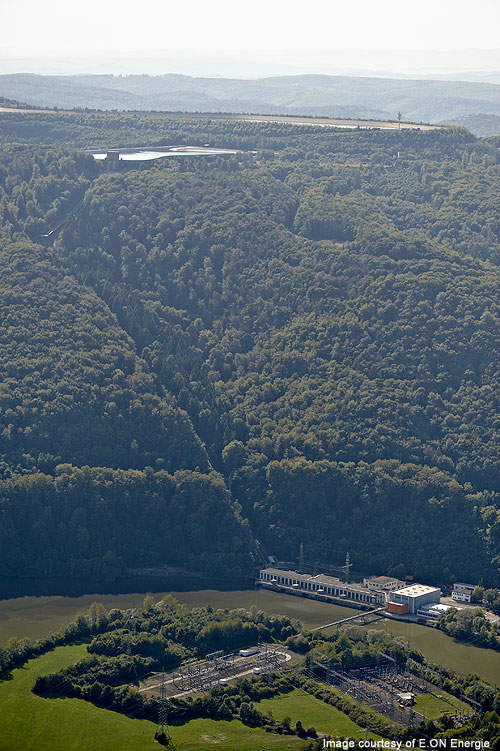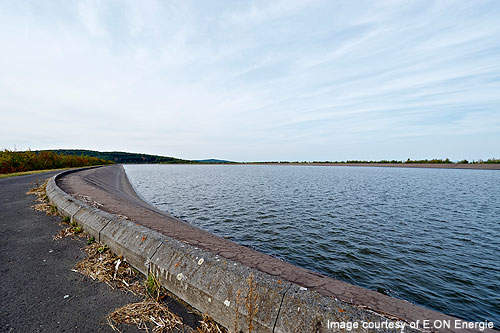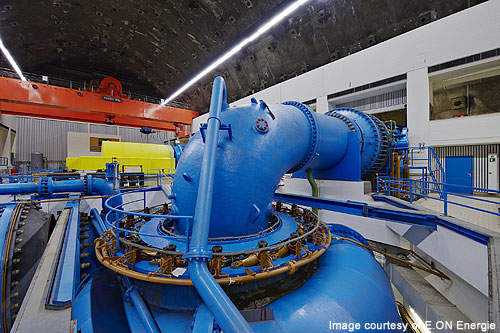Waldeck pumped-storage hydroelectric power station is situated on Lake Eder in the state of Hesse in central Germany. It is owned and operated by E.ON Wasserkraft. The plant was developed in two phases. The first phase, known as Waldeck I, was commissioned in 1932 with four Francis turbines. The second phase, called Waldeck II, was opened in 1975 with two Francis turbines.
Waldeck was upgraded through a €52m modernisation project, which broke ground in April 2006. The modernised plant was inaugurated in June 2010.
With the objective of supporting the growth of renewable energy in Germany, E.ON announced plans to expand the capacity of Waldeck II by 300MW in December 2010. The company received planning consent for the expansion in December 2011. Estimated to cost €250m, the project was scheduled to commence construction in 2012 and be commissioned in 2016. The expansion was, however, postponed due to the increasing pressure on margins for gas-fired power plants.
The pumped storage extension will increase Waldeck’s generation capacity to a total of 920MW.
Meanwhile, in August 2014, Voith was awarded a contract worth €9m ($11.9m) to modernise a generator at the Waldeck 2 power plant. The scope of work includes replacement, assembly and commissioning of the stator and rotor of machine 6 at the plant. The modernisation aims to enhance the life of the machine unit in addition to increasing its efficiency by 10%.
Construction
The modernisation project included refurbishment of Waldeck I and construction of a new state-of–the art pumped storage station. It also involved revamping of the two old turbines, overhauling of the upper basin and construction of a new pressurised duct plant with a 70MW pump turbine (two 35MW generators).
The pressurised duct plant is built on the bank of the lower basin to allow a straight-line connection between the new unit and the existing pipelines. The duct has a diameter of 17m in the generator hall level and 50m at maximum duct depth. The section of the duct located underwater has a draft tube and draft duct.
The modernisation project also involved overhauling of units 5 and 6 and the upper basin of Waldeck II. The other upgrades to Waldeck II included inspection of the units, construction of a new power plant control and protection system, and upgrade of the fire safety and ventilation system.
The planned 300MW extension of Waldeck II will be a green project. The penstock pipes, turbine room and the generating equipment will be constructed underground to make the project more eco-friendly.
The height of the retaining walls will be raised by 10% to increase the volume of water in the upper reservoir of the existing plant. The existing tunnel access will be used.
The power generated will be transferred to the network using the on-site switchyards at Waldeck II.
Waldeck II development
Voith Hydro (earlier known as Voith Siemens Hydro), a joint venture of Voith and Siemens, was appointed as the main contractor for the construction of Waldeck I. The company had supplied turbines, governors and shut-off valves in 1929. It had also won the contract for Waldeck II in 1975 for the supply of turbines and spherical valves.
The pre-planning phase of the modernisation project began in 2004. The pressurised duct plant was built next to Waldeck I. The contract was awarded to a consortium of Bilfinger Berger and Voith Hydro in 2005. Bilfinger carried out the civil works while Voith Hydro supplied the entire electromechanical package including the 70MW reversible pump-turbine, generator, shut-off valves, start-up converter, transformers and control systems.
The overhaul of Waldeck II was implemented in two phases. The first phase, which was implemented during 2005 and 2006, involved overhaul of the upper basin, the hydraulic steel work components and the generator stator of unit 5. A new power plant control and protection system was installed and the turbine, pumps and ball sliders of unit 5 were inspected during this phase. The second phase, which was implemented from 2007 to 2010, involved upgrades to the fire safety and ventillation system and inspection of the pump, turbine and ball sliders of unit 6.
The building contractors for the Waldeck II overhaul were Alstom, ANTROK, BeKor, ARGE BuM Beton-und Monierbau und Feldhaus Bergbau, SAG, SHE-Hannover, TEUPE & Söhne, VA Tech Escher Wyss and Walso Bertschinger.
Fichtner was the structure supervisor and E.ON Engineering and EHS-Laabmayer were the project engineers. Laymeyer International supervised the construction works.
German power market
Germany is Europe’s largest energy market and has a total of 1.7m km of transmission network. The gross electricity production in the country was 639bn KWh in 2008. Most of it was supplied by lignite (23.5%), nuclear (23.3%), hard coal (20.1%) and natural gas (13%) while renewables such as water, wind and biomass accounted for 15.1%.
Of the total renewable energy production, hydroelectric power constituted about 12.7%, generating 21,300GWh, in 2008. By the end of 2008, Germany had 7,500 hydroelectric power plants generating a total output of 4,740MW.
Although the national share of renewable electricity production increased to 16.5% in 2010, the power contributed by hydroelectric plants fell considerably to 19,500GWh.




